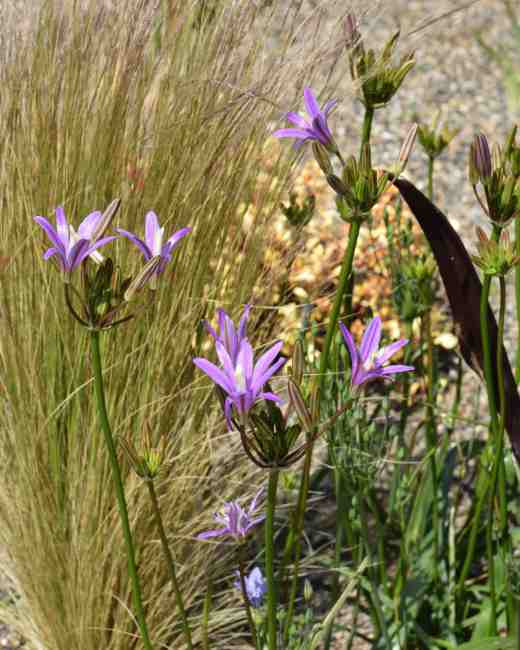The last flowers of spring

Triteleias are funny things. For a start, the naming is a minefield but more of that later – they are planted in autumn, along with all the spring-flowering bulbs, but they don’t bloom until June or July, even later than alliums. This makes them useful in the garden as well as awkward to fit into normal bulb planting. The best way to treat them, or at least those that can be grown outside, is to integrate them into your permanent plantings. They prefer a sunny, well-drained site and they are ideal for those hard-to-plant, dry beds beside a sunny wall. The most common is Triteleia laxa, most often sold as the cultivar ‘Queen Fabiola’. It has a cluster of strappy leaves that emerge in spring and are starting to look tired by flowering time and an umbel of trumpet-shaped flowers on a straight, strong stem. They are often sold as cut flowers. Because they are hardy and have bright blue flowers they make a good alternative to agapanthus, blooming freely even the first year after planting.
Triteleias have had their name changed more than most plants and especially their family. They are sometimes sold as Brodiaea or Bloomeria and although they were originally in the Liliaceae they were rapidly placed in the Alliaceae – and the resemblance is obvious. But now they are in the Themidaceae!
There are a dozen or so species, all except one (from Mexico) from western North America, and most from California and Oregon. The flowers are usually blue or yellow but there are white species too.
Anyway, back to Triteleia laxa. I planted ‘Queen Fabiola’ in the raised beds last autumn and they are just beginning to bloom.

There already seems to be some variation in colour so I suspect that if it ever was a true cultivar it is now a strain and raised from seed. But the two-tone flowers are very attractive anyway. ‘Rudy’ or ‘Rudy Kleiner’ is very striking, with pale blue flowers strongly striped in deep blue and there is a double too (‘Aquarius’?) but I have not seen that.
More experimental is ‘Pink Heaven’, planted at the same time and new to me. There is no pink triteleia species so I don’t know where the pink comes from. But triteleias are closely related to dichelostemma and there are pink and red species so I suspect that these could be the source of the novel colouring. ‘Pink Heaven’ seems to be taller and has larger flowers and although not quite heavenly it is very attractive. What is puzzling is that my flowers are nothing like (well, not identical to) images on the net.

‘Pink Heaven’ was moderately priced but ‘Queen Fabiola’ is ridiculously cheap to buy and well worth a try in a sunny spot.
I have found the Triteleias self-seed very generously and spread along especially if they have access to a gravel area. They give a nice effect though and are easy to remove if wished.
Well they have plenty of gravel so I will be happy if they spread
Triteleia laxa, like many of the native perennials, is difficult to relocate. We can see them bloom, but if we let them die back and then try to find the bulbs later, we never do. They show up where they are unwanted, such as in a driveway, so it makes sense to ‘try’ to relocate them to where they would be more desirable. Triteleia ixioides and Triteleia hyacintha live here also, but I do not remember ever seeing them in the wild locally.